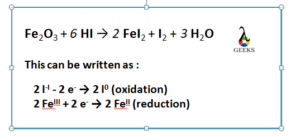Hydrogen Iodide (HI) and Ferrous oxide (Fe2O3) react together to form multiple products. Let us now talk about the reaction between HI + Fe2O3.
Hydroiodic acid is a strong colorless acid that ionizes completely in an aqueous solution. It is used as a reducing agent. Ferric oxide also known as hematite is an odorless, reddish-brown solid prepared by oxidation of Iron. It is an amphoteric oxide having both acidic and basic character.
In this article, we will discuss the reaction’s products, method of balancing, ionic equation, intermolecular forces, reaction enthalpy for the reaction between HI and Fe2O3.
What is the product of HI and Fe2O3?
Hydroiodic acid(HI) reacts with ferrous oxide(Fe2O3) to produce ferrous iodide(FeI2), iodine(I2) and water(H2O).
Fe2O3 + HI = FeI2 + I2 + H2O
What type of reaction is HI + Fe2O3?
The reaction of HI and Fe2O3 is an acid-base neutralization reaction. In this reaction, HI acts as a strong acid and Fe2O3 acts as a base.
How to balance HI + Fe2O3?
The reaction Fe2O3 + HI = FeI2 + I2 + H2O is not balanced yet.
To balance the above equation, follow the steps given below:
- The reactants and the products are labeled by a, b, c, d and e variables to represent the unknown coefficients as:
aFe2O3 + bHI = cFeI2 + dI2 + eH2O - The same type of elements is rearranged together, and then the coefficients are equated.
- After rearranging by their stoichiometric proportion, we get :
Fe=2a=c, O=3a=e, H=b=2e, I=b=2c=2d - Use the Gaussian elimination method to determine the values of the coefficients,
a=1 , b=6 ,c=2 , d=1, e=3 - Hence the overall balanced equation is:
Fe2O3 + 6HI = 2FeI2 + I2 + 3H2O
HI + Fe2O3 titration
For analysis of Fe2O3, gravimetric analysis method is used in which HCl is used for the titration process. But titration of Fe2O3 using HI is not possible since HI is a strong acid and Fe2O3 is amphoteric in nature.
HI + Fe2O3 net ionic equation
The net ionic equation of the reaction of HI+ Fe2O3 is,
2Fe3+ + 3O2- + 4I– = 2Fe2+ +3OH– + I2
Follow the steps to get the net ionic equation of the reaction of HI+ Fe2O3,
- Firstly the chemical states are indicated in the equation:
Fe2O3 (aq.) + 6HI (aq.) = 2FeI2 (aq.) + I2(s) + 3H2O (aq.) - Then the corresponding compounds are split into their ionic forms as follows:
2Fe3+ + 3O2- + 6H+ + 6I– = 2Fe2+ + 2I– + 6H+ +3OH– + I2 - Thus the final ionic equation is:
2Fe3+ + 3O2- + 4I– = 2Fe2+ +3OH– + I2
HI + Fe2O3 conjugate pairs
HI+ Fe2O3 has the following conjugate pairs-
- The conjugate base for HI is I–
- There exist no conjugate pair for Fe2O3
HI and Fe2O3 intermolecular forces
- In case of HI, there exists a strong dipole-dipole interaction between the ions.
- In case of Fe2O3, it is a polar covalent molecule.
HI + Fe2O3 reaction enthalpy
HI+ Fe2O3 reaction enthalpy is -411.2 KJ/mol.
The formula for enthalpy calculation is: Enthalpy of Product – Enthalpy of Reactant
| Molecule | Enthalpy(KJ/MOL) |
|---|---|
| HI | 26.48 |
| Fe2O3 | -824.2 |
| FeI2 | -109.83 |
| H2O | -285.83 |
| I2 | 0 |
Is HI + Fe2O3 a buffer solution?
The reaction of HI+ Fe2O3 will not give a buffer solution. It is because of the presence of a strong acid like HI. It will change its pH rapidly and hence not form a buffer solution.
Is HI + Fe2O3 a complete reaction?
The reaction HI+ Fe2O3 is a complete reaction because the products are formed and no more steps are left to be completed.
Is HI + Fe2O3 an exothermic or endothermic reaction?
HI+ Fe2O3 is an exothermic reaction because of the negative enthalpy value obtained from the chemical reaction.
Is HI + Fe2O3 a redox reaction?
The reaction HI+ Fe2O3 is a redox reaction. Here HI acts as a reducing agent and Fe2O3 acts as an oxidizing agent.

Is HI + Fe2O3 a precipitation reaction?
The reaction HI+ Fe2O3 is a precipitation reaction because dark purple crystals of Iodine are obtained which is almost insoluble in water.
Is HI + Fe2O3 reversible or irreversible reaction?
The reaction HI+ Fe2O3 is an irreversible reaction since complete products are obtained that may not revert back to the reactants.
Is HI + Fe2O3 displacement reaction?
The reaction HI+ Fe2O3 is an example of a double displacement reaction because neutralization reactions are an example of double displacement reactions in which FeI2 is produced as a salt along with water.
Conclusion
Reaction of hydroiodic acid with ferrous oxide result in the formation of ferrous iodide as a salt along with water and also iodine crystals are also obtained that are insoluble in water.

Hello… , I am Bhaswati Ghose. I have completed my master’s from St. Xavier’s College, Ranchi. My specialization subject was organic chemistry. I’m working as a subject matter expert in chemistry.